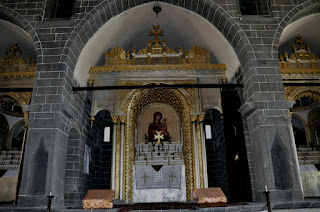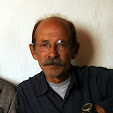On May 6, 2002, I wrote:
“The Armenian church was frightening in its decaying sadness and squalor. Inside the compound where 2 Armenian families lived stood a monumental skeleton of the former church, its stone arches standing naked in regimental order.
“The old man, likely shrinking in size every day, led me through the muddy and garbage strewn courtyard to a small building. He unlocked the blue door, the only splash of color to be seen, and ushered me into a small church.
“Anton turned on the lights, but it was still dark, all the windows long since permanently boarded up. It looked like mildew, but it didn't smell like it. It was fresh and cool. Wide-cuffed tan-and-brown frocks with large metal crosses attached to the shoulders hung on one wall; near-dead crimson gantlets were piled on a small table; and, bibles in varying states of disuse were stacked in two nearby alcoves.
“Anton busied himself straightening up remnants of past lives while I tried to absorb it all. The alter area was a garage sale of Virgin Mary memorabilia. I felt that if I touched anything it would crumble into dust. But of course I did, and of course it did not.
“The future of the church's community is already past.”
March 19, 2012
I knock on the thick steel door in a back passageway of Diyarbakir's old city enclosed in its massive basaltic walls. I knew the way well having returned many times over the years. But now there are two gleaming brass door knobs circled in curvacious Armenian letters. A young man comes, and after a short introduction he welcomes me in, closing and locking the door behind us.
Although I knew that Surp (Saint) Giragos church had just undergone a complete restoration, I was unprepared.
Diyarbakir's past dominant cultures is a literal Who's Who of Anatolian/Middle Eastern empires, from the Hurrians 5,000 years ago and likely before, continuing uninterrupted through the Ottoman Empire. Overlooking the Tigris River it is now the largest city in Kurdish-dominated southeastern Turkey.
Periods of history bore witness to vibrant Armenian populations as late as the waning days of the Ottoman Empire, and largely ending with their genocide in 1915. The remnant Armenian community essentially left the city in the 1990s due to political and economic reasons, some relocating to Istanbul, others to Europe.
Surp Giragos church, originally constructed in the 16th century, was the largest church in the region and particular in its 7 alters. It was rebuilt several times through the centuries, and following WWI it was used by the Turkish state as a military depot and other secular purposes. The church was repatriated to the Armenians in the 1960's; in the nineties its flat earth-covered roof collapsed.
Its restoration began in 2009 and was principally funded by a foundation created for this purpose, and the municipality of Diyarbakir led by its Kurdish mayor. The Armenian Patriarchate from Istanbul officiated the internationally attended consecration mass in October, 2011. There has not been another service held in the church since.
How many Armenians remain in Diyarbakir? Hasan, one of the two young Muslim Kurds caretakers, tells me, “Maybe there are 15, but I don't really know.” Later in the compound I share a tulip-shaped cup of amber tea with an Armenian man and his daughter. He is from Siverek, 90 kms to the east. “In Diyarbakir? No, there are not any here. They have all left.”
Hasan allows me to visit the small chapel I visited 10 years ago. He unlocks the blue door and light streams in. Although swept clean and empty, it smells the same.
I knew that Anton had moved to Istanbul in 2004 due to poor health. I ask about him. He is still in Istanbul but his health continues to fail, I am told. He is blind and can no longer speak.
But Surp Giragos glories in its restoration.
Postscript - The Bell Rings On
On November 4th, 2012 the new bell, the church's first since 1915, was to be rung. I visited Surp Giragos two weeks prior and admired the impressive100 kg bell that waited to be hoisted up the still-under-construction bell tower.
I returned the day before the natal ringing of the bell. A gathering was a foot. I spoke with a Canadian Armenian who arrived just that morning for the celebration. He was tired but seemed at home. The bell hung unseen above looking down on squads of workers scurrying with intent.
I was unable to stay on, but I am sure the Armenian Patriarchate from Istanbul got along just fine without me.
............................
(December, 2013) from Al-Monitor:
http://asbarez.com/117363/turkey%E2%80%99s-kurds-seek-forgiveness-for-part-in-genocide/
(January 2015) from the New Yorker:
http://www.newyorker.com/magazine/letter-from-turkey
“The Armenian church was frightening in its decaying sadness and squalor. Inside the compound where 2 Armenian families lived stood a monumental skeleton of the former church, its stone arches standing naked in regimental order.
“The old man, likely shrinking in size every day, led me through the muddy and garbage strewn courtyard to a small building. He unlocked the blue door, the only splash of color to be seen, and ushered me into a small church.
“Anton turned on the lights, but it was still dark, all the windows long since permanently boarded up. It looked like mildew, but it didn't smell like it. It was fresh and cool. Wide-cuffed tan-and-brown frocks with large metal crosses attached to the shoulders hung on one wall; near-dead crimson gantlets were piled on a small table; and, bibles in varying states of disuse were stacked in two nearby alcoves.
“Anton busied himself straightening up remnants of past lives while I tried to absorb it all. The alter area was a garage sale of Virgin Mary memorabilia. I felt that if I touched anything it would crumble into dust. But of course I did, and of course it did not.
“The future of the church's community is already past.”
March 19, 2012
I knock on the thick steel door in a back passageway of Diyarbakir's old city enclosed in its massive basaltic walls. I knew the way well having returned many times over the years. But now there are two gleaming brass door knobs circled in curvacious Armenian letters. A young man comes, and after a short introduction he welcomes me in, closing and locking the door behind us.
Although I knew that Surp (Saint) Giragos church had just undergone a complete restoration, I was unprepared.
Diyarbakir's past dominant cultures is a literal Who's Who of Anatolian/Middle Eastern empires, from the Hurrians 5,000 years ago and likely before, continuing uninterrupted through the Ottoman Empire. Overlooking the Tigris River it is now the largest city in Kurdish-dominated southeastern Turkey.
Periods of history bore witness to vibrant Armenian populations as late as the waning days of the Ottoman Empire, and largely ending with their genocide in 1915. The remnant Armenian community essentially left the city in the 1990s due to political and economic reasons, some relocating to Istanbul, others to Europe.
Surp Giragos church, originally constructed in the 16th century, was the largest church in the region and particular in its 7 alters. It was rebuilt several times through the centuries, and following WWI it was used by the Turkish state as a military depot and other secular purposes. The church was repatriated to the Armenians in the 1960's; in the nineties its flat earth-covered roof collapsed.
Its restoration began in 2009 and was principally funded by a foundation created for this purpose, and the municipality of Diyarbakir led by its Kurdish mayor. The Armenian Patriarchate from Istanbul officiated the internationally attended consecration mass in October, 2011. There has not been another service held in the church since.
How many Armenians remain in Diyarbakir? Hasan, one of the two young Muslim Kurds caretakers, tells me, “Maybe there are 15, but I don't really know.” Later in the compound I share a tulip-shaped cup of amber tea with an Armenian man and his daughter. He is from Siverek, 90 kms to the east. “In Diyarbakir? No, there are not any here. They have all left.”
Hasan allows me to visit the small chapel I visited 10 years ago. He unlocks the blue door and light streams in. Although swept clean and empty, it smells the same.
I knew that Anton had moved to Istanbul in 2004 due to poor health. I ask about him. He is still in Istanbul but his health continues to fail, I am told. He is blind and can no longer speak.
But Surp Giragos glories in its restoration.
Postscript - The Bell Rings On
On November 4th, 2012 the new bell, the church's first since 1915, was to be rung. I visited Surp Giragos two weeks prior and admired the impressive100 kg bell that waited to be hoisted up the still-under-construction bell tower.
I returned the day before the natal ringing of the bell. A gathering was a foot. I spoke with a Canadian Armenian who arrived just that morning for the celebration. He was tired but seemed at home. The bell hung unseen above looking down on squads of workers scurrying with intent.
I was unable to stay on, but I am sure the Armenian Patriarchate from Istanbul got along just fine without me.
............................
(December, 2013) from Al-Monitor:
http://asbarez.com/117363/turkey%E2%80%99s-kurds-seek-forgiveness-for-part-in-genocide/
(January 2015) from the New Yorker:
http://www.newyorker.com/magazine/letter-from-turkey












Some pretty haunting pictures. Ironically, they remind me of my time in Nargorno Karabagh, where Armenians forcibly removed Azerbaijanis. Dilapidated mosques look just about the same, minus the Virgin Mary symbols scattered throughout.
ReplyDeleteRob, If your pictures are haunting, your stories are even more so: of a church that is not a church; of an Imam who doesn't want to be an Imam, but counts the salary as a blessing; of the weary traveler, who even when he finally leaves Diyarbakir, returns . . . for the warmth of the bus that took him out to Van. Makes for extraordinary tales.
ReplyDelete